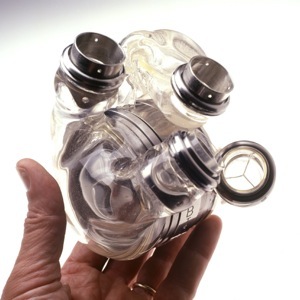Abiocor Replacement Heart

TOTAL ARTIFICIAL HEARTS
The Abiocor replacement heart was the world’s first and still is the only self contained artificial heart. It differs from Syncardia artificial heart due to it being completely enclosed inside the chest requiring no drivelines outside the body. It also differs from Syncardia as it serves to help those end-stage heart failure patients who are not eligible for heart transplantation or mechanical devices to help the heart pump blood. What also separates it from the Syncardia artificial heart is it is only available for men at the moment due to it size.
The Abiocor heart consists of the artificial replacement heart, the internal battery source, the internal controller, and an implantable transcutanous energy transfer (TET) apparatus, and an external battery. The replacement heart, system made up of titanium and polyurethane, contains a motor driven hydraulic pumping system and two artificial ventricles containing trileaflet valves to direct blood flow. Within the unit, there is also an energy converter energy between the ventricles and an atrial balance chamber, which serves to maintain right and left side balance. The internal controller drives the energy converter inside the replacement heart, monitors, and regulates its output of the heart based on the need of the patient. The TET system is what powers the entire abiocor system and charges the internal battery. It uses high frequency power that is transmitted across the skin of the patient, which comes from the external TET coil, and converts it to direct current. It also consists of external components which works with the surgically implanted pieces as to serve as a power source, as well as to monitor and adjust the replacement heart.
The pumps which are inside the artificial heart drive blood in and out of the apparatus. The left and right blood pumps alternate in pumping blood to the lungs and various areas of the body. As blood enters each ventricle it is pumped out, where the energy converter keeps blood flow normal in each pump. This is achieved by silicone hydraulic fluid that is found inside the energy converter which separates the left and right side with membranes. Another pump which is found inside the energy converter exerts force against these membranes which leads to the pumps to empty and fill.

Since 2004, 15 patients have been implanted with the Abiocor replacement heart, where patients had an average 5 month survivability.. One study showed that of patients fitted with the device had a 71% survival rate to reach 30 days, and 43% survival rate to reach 60 days compared to only a 13% survival rate based on medical therapy alone. Four patients were able to survive 151, 181, 243, 512 days with the replacement heart.

